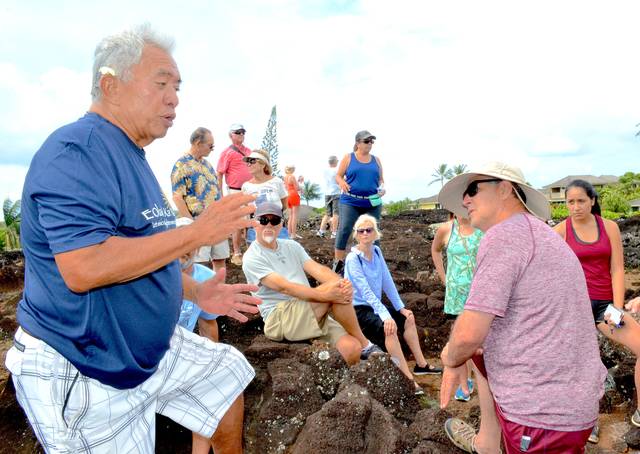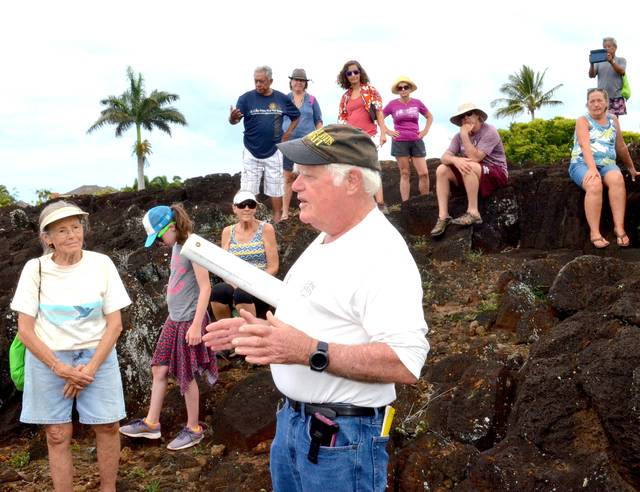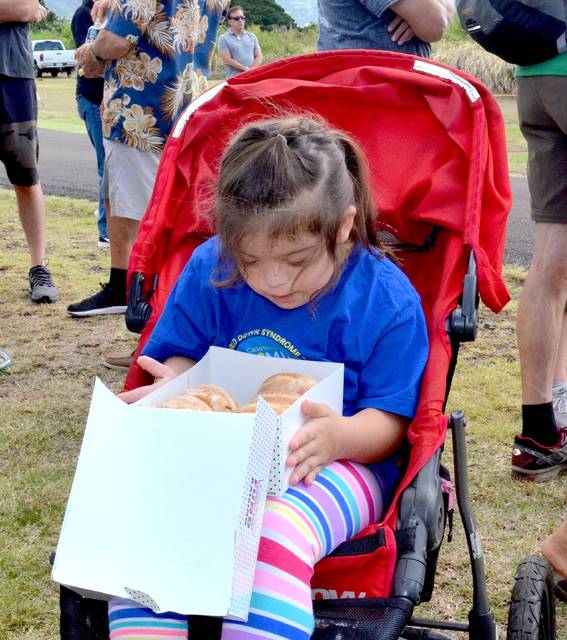For the past four years, Koloa resident Katrina Martinez has taken her daughter Ella, 6, on the guided Hapa Trail tour during Koloa Plantation Days.
“I think it’s valuable to participate in Koloa Plantation Days. I’ve lived here for 23 years. It’s really important to engage in your community and learn about the history and cultural practices,” Martinez said.
The road is in the middle of the Koloa Fields System, which provided food for Koloa and beyond. During the Gold Rush, sweet potatoes were grown in the area and sent to California to feed gold miners.
About 100 people gathered at St. Raphael Church in Poipu Saturday for coffee hour and the guided walk. They were led by archaeologist Hal Hammatt, who mapped out the area in the 1970s with Francis Ching, along with Malama Koloa Director Ted Blake.
The mapping was challenging and took months to complete, using a compass and tape.
Hammatt said they believe the original use of the road was to bring crushed coral up from the beach to use as mortar in the original homes of the area.
There are a number of reasons events like this are important, Hammatt said. The first is that they bring community together.
“No. 2, (the community) learns the significance of things they look at that they may not know about. No. 3, it’s great fun and No. 4, these are great people in the wonderful community of Koloa,” he said.
Princeville resident Diane McDonald, who teaches at Hanalei School, came with a fellow teacher to learn about the historical aspect of Hapa Trail. One thing she learned during the tour is that dry Koloa had an extensive water system.
“It’s pretty impressive that they were able to make a go, the people living here,” she aid. “What a hardship it was to do that; pretty incredible.”
Because the North Shore is so wet, McDonald said, it would seem easier to maintain an agricultural lifestyle on that side of the island.
“I’m really enjoying the walk a lot,” said Harry McCarthy, a retired judge who recently moved to Poipu with his wife. “It’s really interesting to learn a lot about the culture, people who lived here and how they overcame tremendous obstacles to be able to build what they did many, many years ago.”
McCarthy said it was interesting to see ancient structures next to new structures.
Connie Schwarze, who lives in Poipu for half of the year, said she enjoyed the guided walk.
“All of the archaeology that we didn’t know exists,” she said. “The waterways that they built that — just normally walking — you wouldn’t know. You would just think that maybe they moved when they built the houses over here; you wouldn’t know that they’re ancient waterways.”
The event ended with lunch at Poipu Beach Park.
•••
Bethany Freudenthal, courts, crime and county reporter, can be reached at 652-7891 or bfreudenthal@thegardenisland.com.






I’ve always wondered about those extension stone walls and terraces along the Koloa Poipu area. We walked along a set of stone walls that ran from Sheraton to the back of the Catholic Church. It seems to end next to that stream next to the cane haul road.
Maybe that’s where the ancient Hawaiian tap into that stream to irrigate the lower dry areas in the Poipu area? I must have take extension planning to overcome the various elevation levels of that land so that the water flows most effectively. Yet the Missionaries called Hawaiians “heathen savages”, the saveage were none other than themselves.